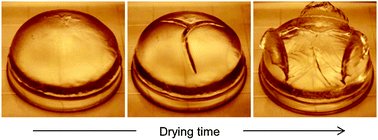Spontaneous exfoliation of a drying gel†
Abstract
Wet starch cracks when it dries inhomogeneously, while hot glass cracks when it cools non-uniformly. In both cases, differential shrinkage induced by drying/cooling from the surface causes superficial cracks to grow perpendicular to the surface in different patterns. In contrast with these observations of bulk cracking in brittle materials, when a soft and homogeneously swollen polymer gel dries, differential strains lead to the peeling of a thin layer that spontaneously tears away from the bulk. Continued drying leads to the process repeating itself, forming a peeled-layered structure. The emergent thickness of the exfoliated layer is a function of both the geometry of the original gel and the physical parameters associated with the drying rate and external temperature. We characterize the experimental conditions under which layer peeling can arise, and use simulations to corroborate these observations. Finally, a minimal theory explains the scaling of the peel thickness, consistent with our experiments.


 Please wait while we load your content...
Please wait while we load your content...